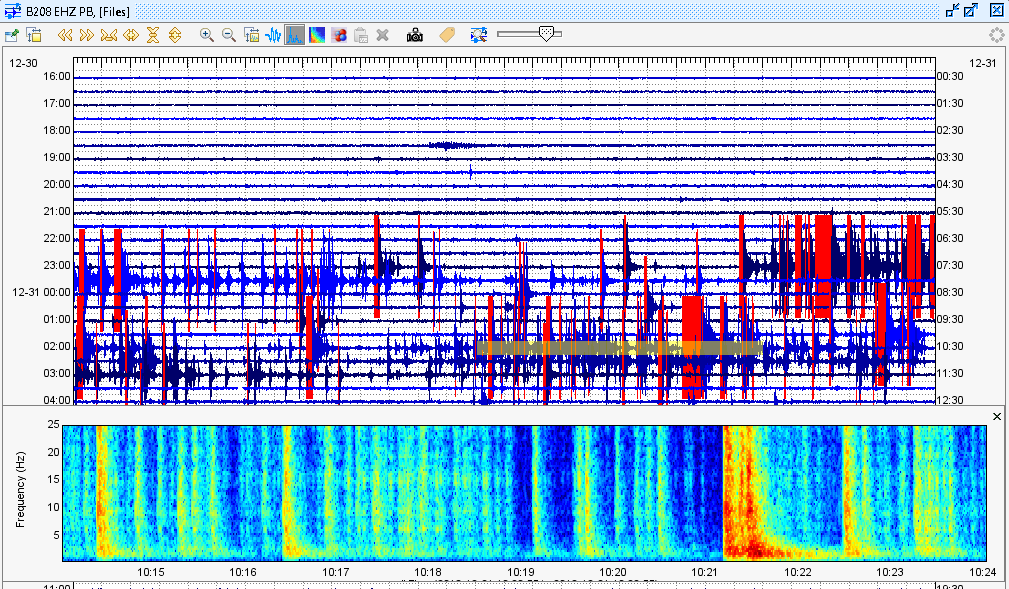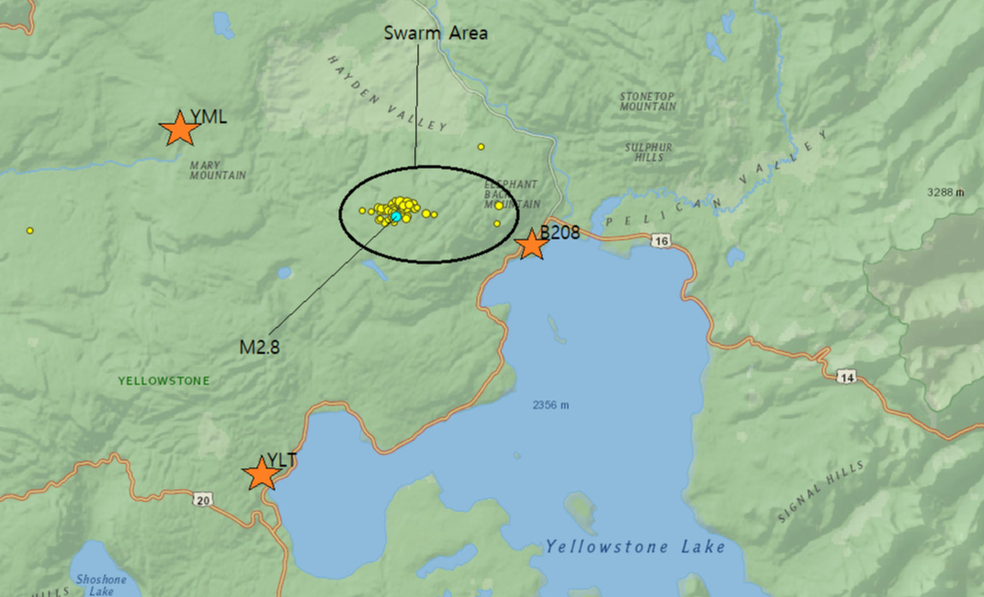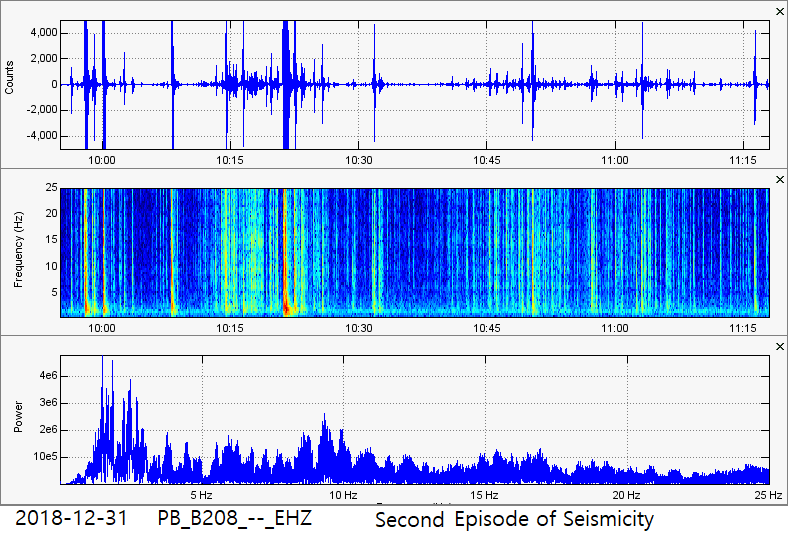|
To see information and plots of this very energetic swarm just west of Yellowstone Lake, please click the title of this post or "read more" to continue. On New Years Eve morning (Dec 31), a very energetic swarm hit just west of the northern tip of Yellowstone Lake within Yellowstone Caldera. In the image above, you can see the 58 earthquakes that were reported in regards to 3 of the closest seismic stations. The largest event, reportedly a magnitude 2.8, is marked above as well as the swarm area. This swarm began at about 7:10UTC and ended around 12:45UTC, December 31, 2018 (12:10am to 5:45am MST, same date). Many of the earthquakes were small but many also were much larger. Many of the events also occurred in rapid succession, sometimes occurring at about 6 earthquakes in a minute or so. The large majority of this swarm also took place in two separate episodes during that time span of 5 hours and 35 minutes (you will see that below in a second). Using the seismic program WAVES, along with data collected from several neighboring stations, I determined there were a total of (both tiny and large) 255 earthquakes within that time frame. Only around 58 have been reported. That is absolutely stunning! That was determined by cross correlating their P wave arrivals. I was not attempting to locate them but I was simply attempting to judge how many earthquakes actually occurred during this time frame. At the end of this post, you will see my video where I analyzed these events and another video showing some of the live stream I recorded of this swarm, along with the swarm's seismic audio which sounds pretty cool! This was an extremely fast paced swarm. But what caused it? Well, I cannot say 100% for sure what caused this swarm. However the characteristics of the earthquakes themselves were much different from any other swarm during 2018. For example, it is my theory that the large February 2018 swarm at Maple Creek (far to the northwest of the Dec. 31 sequence) was caused by local tectonic stresses due to the upwelling of hydrothermal fluids. This is due to the characteristics of each seismic event that happened during that time period. I also believe many of the short bursts in rapid fire swarming near the northern tip of West Thumb lake are caused by a new hydrothermal system forming. However, the New Years Eve swarm (which locally occurred just as New Years Eve started) seems highly indicative of being caused by a small amount of magma itself. This is due to three factors: 1. A few, very small low frequency events were spotted along with a possible low frequency background tremor. However it was quite weak and still do not know what it was caused by. 2.The style of this swarm was eerily reminiscent of the swarm caused by the 2008-2009 dike intrusion of Yellowstone Lake. 3. Multiple possible hybrid earthquakes were detected indicating a mix of processes, not just normal tectonic processes. Below I show eleven 3-plot images of the most interesting parts of the swarm, helicorders of this swarm from multiple stations, and two 3-plot images showing this swarm was separated by two episodes of seismicity. Remember to please always pay attention to chart labels first, before you read the data, and also pay attention to any captions beneath any images. Remember slide shows can be paused or images skipped.  The time frame for these plots is about an hour. Remember, most of the seismicity was contained within two episodes during that time frame of 5 hours and 35 minutes. Amplitudes have been cut on the seismogram plot so some of the smaller earthquakes could be seen. Each spike you see is an earthquake and some earthquakes you cannot see since they occurred so close to other earthquakes! Surface noise was non existent on this seismic station during this time period. Directly below are the seismic helicorders for multiple stations in the area during the time period of the swarm. DISCLAIMER: For some weird reason, the seismic program SWARM glitched and read "Dec 31, 2019" instead of "Dec 31, 2018". The correct date for the plots below would be "Dec 31, 2018". December 2019 hasn't even occurred yet, seeing I am writing this on August 30, 2019. There are 41 images in the slideshow below: Would you like to watch the in-depth video where I analyze most of this swarm? Then please watch the video below or CLICK HERE to visit the YouTube page for this video. Since it is quite long, I suggest going to the video page on YT since I have all of the separate parts listed in the description box. Now when I first saw this swarm emerging I immediately let my subscribers on YT know via a YT post. I was very tired and it was late at night so I decided to do all of my analysis when I woke up in the morning. I decided to record the live stream via SWARM for data from Borehole 208 at Yellowstone Lake. To my surprise, I caught a good amount of it on the live feed. The video below shows the live feed for some of the Dec. 31 swarm. It is sped up of course and at the end of the video I include seismic audio of this swarm. It is best to use headphones for the seismic audio. You can watch, and listen to, the video directly below or you can visit it on my YouTube channel if you CLICK HERE.
0 Comments
Leave a Reply. |
About
Please click a post title to view the data pertaining to that event! Archives
February 2020
Categories |



 RSS Feed
RSS Feed